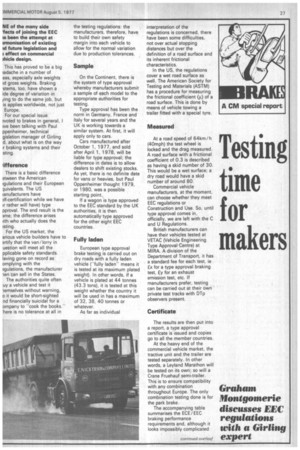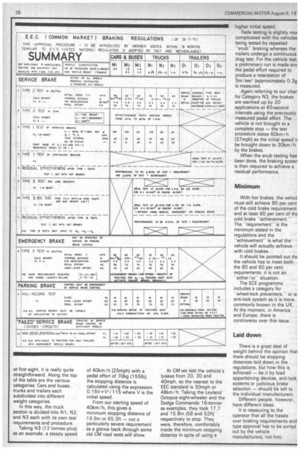Testing time for makers
Page 29

Page 30

If you've noticed an error in this article please click here to report it so we can fix it.
NE of the many side facts of joining the EEC is been the attempt at trmonisation of existing id future legislation and ; effect on commercial ;hide design.
This has proved to be a big :adache in a number of eas, especially axle weights id gross weights. Braking stems, too, have shown a ide degree of variation in ying to do the same job, but is applies worldwide, not just Europe.
For our special issue ?voted to brakes in general, I we been talking with Paul ppenheimer, technical gislation manager of Girling d, about what is on the way 1r braking systems and their sting.
lifference
There is a basic difference atween the American igulations and their European iuivalents. The US ianufacturers have ?If-certification while we have ir rather will have) type pproval. The end result is the ime; the difference arises ith who actually does the :sting.
For the US market, the arious vehicle builders have to artify that the van/lorry in uestion will meet all the pplicable safety standards. laving gone on record as omplying with the agulations, the manufacturer len can sell in the States.
The authorities quite often uy a vehicle and test it lemselves without warning, o it would be short-sighted nd financially suicidal for a ompany to "cook the books." 'here is no tolerance at all in the testing regulations: the manufacturers, therefore, have to build their own safety margin into each vehicle to allow for the normal variation due to production tolerances.
Sample
On the Continent, there is the system of type approval whereby manufacturers submit a sample of each model to the appropriate authorities for testing.
Type approval has been the norm in Germany, France and Italy for several years and the UK is working towards a similar system. At first, it will apply only to cars.
Cars manufactured after October 1, 1977, and sold after April 1, 1978, will be liable for type approval; the difference in dates is to allow dealers to shift existing stocks. As yet, there is no definite date for vans or heavies, but Paul Oppenheimer thought 1979, or 1980, was a possible starting point., If a wagon is type approved to the EEC standard by the UK authorities, it is then automatically type approved for the other eight EEC countries.
Fully laden European type approval brake testing is carried out on dry roads with a fully laden vehicle ("fully ladenmeans it is tested at its maximum plated weight). In other words, if a vehicle is plated at 44 tonnes (43.3 tons), it is tested at this weight whether the country it will be used in has a maximum of 32, 38, 40 tonnes or whatever.
As far as individual interpretation of the regulations is concerned, there have been some difficulties, not over actual stopping distances but over the definition of a road surface and its inherent frictional characteristics.
In the US, the regulations cover a wet road surface as well. The American Society for Testing and Materials (ASTM) has a procedure for measuring the frictional coefficient (p,) of a road surface. This is done by means of vehicle towing a trailer fitted with a special tyre.
Measured
At a road speed of 64km/h (40mph) the test wheel is locked and the drag measured. A road surface with a frictional coefficient of 0.3 is described as having a skid number of 30. This would be a wet surface; a dry road would have a skid number of around 80.
Commercial vehicle manufacturers, at the moment, can choose whether they meet EEC regulations or Construction and Use. So, until type approval comes in, officially, we are left with the C and U Regulations.
British manufacturers can have their vehicles tested at VETAC (Vehicle Engineering Type Approval Centre) at MIRA. A division of the Department of Transport, it has a standard fee for each test, ie Ex for a type approval braking test, Ey for an exhaust emission test, etc. If manufacturers prefer, testing can be carried out at their own private test tracks with DTp observers present.
Certificate
The results are then put into a report, a type approval certificate is issued and copies go to all the member countries.
At the heavy end of the commercial vehicle market, the tractive unit and the trailer are tested separately. In other words, a Leyland Marathon will be tested on its own; so will a Crane Fruehauf semi-trailer. This is to ensure compatibility with any combination throughout Europe. The only combination testing done is for the park brake.
The accompanying table summarises the ECE/ EEC braking performance requirements and, although it looks impossibly complicated
at first sight, it is really quite straightforward. Along the top of the table are the various categories: Cars and buses, trucks and trailers each subdivided into different weight categories.
In this way, the truck section is divided into Ni, N2, and N3 each with its own test requirements and procedure.
Taking N3 (12 tonnes plus) as an example, a steady speed
of 40km/h (25mph) with a pedal effort of 70kg (1551b), the stopping distance is calculated using the expression 0.15V+V-1115 where V is the initial speed.
From our starting speed of 40km/h, this gives a minimum stopping distance of 19.9m or 65.3ft — not a particularly severe requirement as a glance back through some old CM road tests will show. At CM we test the vehicle's brakes from 20, 30 and 40mph, so the nearest to the EEC standard is 30mph or 48km/h. Taking the Leyland Octopus eight-wheeler and the Dodge Commando 16-tonner as examples, they took 17.7 and 15.8m (58 and 52ft) respectively to stop. They were, therefore, comfortably inside the minimum stopping distance in spite of using a
higher initial speed.
Fade testing is slightly moi complicated with the vehicles being tested by repeated "snubbraking whereas the trailers undergo a continuous drag test. For the vehicle test, a preliminary run is made anc the pedal effort required to produce a retardation of 3m/sec' (approximately 0.3g is measured.
Again referring to our char for Category N3, the brakes are warmed up by 20 applications at 60-second intervals using the previously measured pedal effort. The vehicle is not brought to a complete stop — the test procedure states 60km /h (37mph) as the initial speed ti be brought down to 30km /h by the brakes.
When the snub testing has been done, the braking syster is then required to achieve a residual performance.
Minimum With hot brakes, the vehicl must still achieve 80 per cent of the cold brake requirement and at least 60 per cent of thE cold brake ''achievement.The "requirementis the minimum stated in the regulations and the "achievement" is what the vehicle will actually achieve with cold brakes.
It should be pointed out thE. the vehicle has to meet both the 80 and 60 per cent requirements: it is not an "either/or" situation.
The ECE programme includes a category for "wheel-lock preventers,'' or ar anti-lock system as it is more commonly known in the UK. At the moment, in America and Europe, there is controversy over this issue.
Laid down
There is a great deal of weight behind the opinion that there should be stopping distances laid down in the regulations, but how this is achieved — be it by load apportioning devices, anti-lock systems or judicious brake selection — should be left to the individual manufacturers.
Different people, however, have different ideas.
It is reassuring to the operator that all the hassle over braking requirements and type approval has to be sorted out by the vehicle manufacturers, not him.








































































































